Though some unisexual sponge species are also known, most sponges are monoecious or bisexual. Although sponges are bisexual (hermaphrodite) cross fertilization occurs as a rule as the production timing of sperm and ova are different. The sperm and ova are derived from the undifferentiated amoebocytes called as archaeocytes. The sperm and ova are also known to be derived from choanocytes which later undergo gametogenesis to form sperm or ova.
Sponges exhibit protandry, production of sperms first and ova later or protogyny, production of ova first and sperms later. Both protandry and protogyny facilitate cross fertilization.
The sperm mother cell or a spermatogonium is the enlarged archaeocytes. This spermatogonium is surrounded by one or more flattened cover cells to form spermatocyst. These cover cells are derived from other amoebocytes. Now these spermatogonia undergo two to three maturation divisions to form spermatocytes and these spermatocytes later give rise to spermatozoa. A matured spermatozoon consists of a rounded nucleated head and a tail. The lashing movement of the tail helps the spermatozoon to reach other sponges.
The egg mother cell or an oocyte is derived from large archaeocytes which have distinct nucleus. Sometimes the oocytes also arise from the choanocytes. This oocyte moves like an amoebocytes engulfing other cells. These engulfed cells act as the nursing cells for the oocyte. When fully grown the oocyte undergoes two maturation divisions to form ovum which lies in the wall of the radial canal or spongocoel, ready to be fertilized by the sperm of other sponge.
Sperms are released out from sponge through the outgoing water from osculum. The sperms thus releases make their way into another sponge through incoming water by ostia. Choanocytes act as nurse cells and transport the sperm to the ova which lie in the flagellated choanoderm. The fertilization is internal and cross type.
Early development takes place within the maternal sponge leading to the formation of larval stages. The larval stages bear flagella, which help them to escape out from the maternal sponge body. The larva thus escaped gets attached to a suitable substratum, metamorphose and grow into adult sponge. Sponges have two types of larvae,
Amphiblastula: It is hollow, oval larval stage characteristic of calcareous sponges (Scypha). Anterior half of amphiblastula bears flagella while the posterior half is free from flagella.
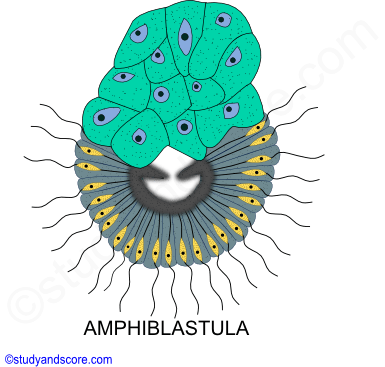
Parenchymula: It is solid, oval or flattened larval stage characteristic of calcareous sponges, Hexactanellida and most Desmospongia. The entire larva is covered by flagella.
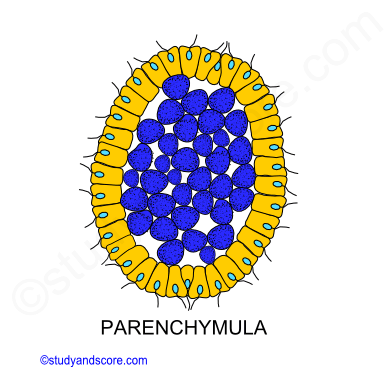
With the help of external flagella, the motile larvae escapes from the parental body and swim for a few hours to many days. Finally they settle down, become attached to some solid object, metamorphose and grow into an adult.
Asexual reproduction in sponges is by
1. Budding
2. Fission
3. Formation of reduction bodies
4. Formation of gemmules
By this method the number of individuals in the colony may increase or new colonies may be formed. An outgrowth from the sponge body wall may arise either at the base or near the attached end to form bud. This bud is the result of bulging of pinacoderm to receive numerous archeocytes collected at the internal surface of the body wall.
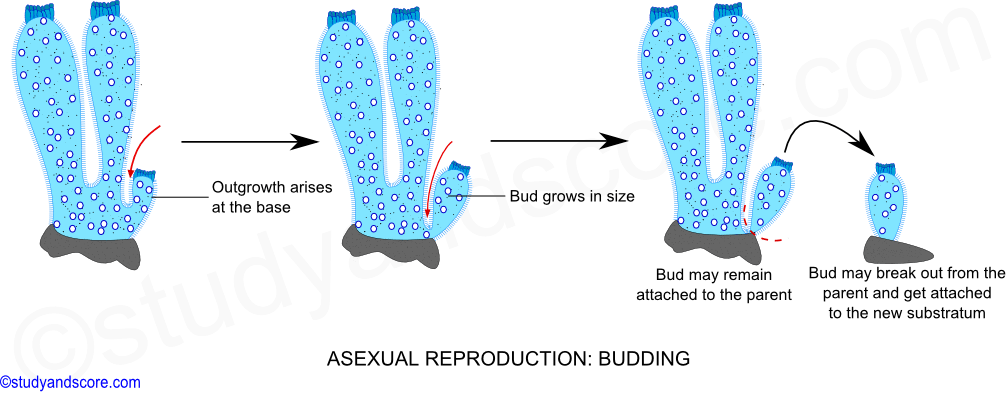
The bud so formed grows in size, breaks off an osculum at its free distal end and thus becomes an adult individual. It either remains attached to the parent sponge or may get detached to form a new sponge by fixing itself to a suitable substratum.
In this type of reproduction parts of the sponge body are thrown off from the sponge body. The sponge is hypertrophied over a limited area developing a line of weakness. Hypertrophy is the non-tumorous enlargement of a tissue or an organ as a result of the increase in the size rather than the number of constituent cells.
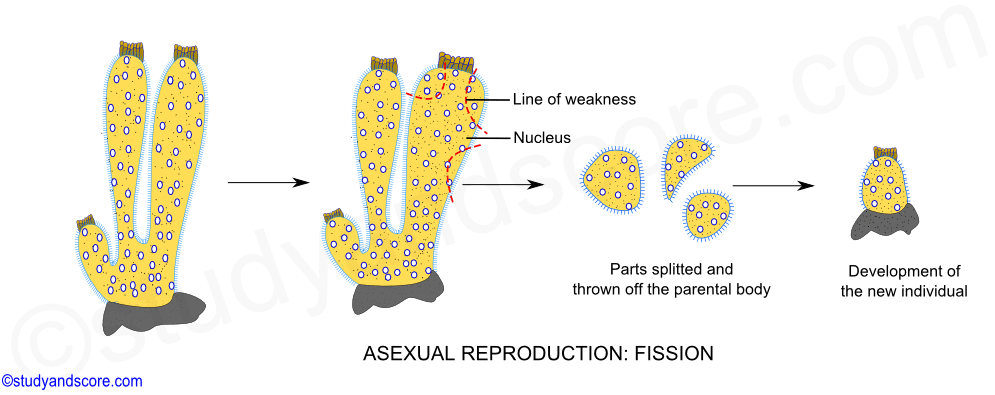
Along this weak line, splitting occurs and this part is thrown off. The part of parental sponge thus thrown off develops into an adult individual, breaks off an osculum at its free distal end and gets attached to a suitable substratum. This new individual develops a new colony by budding.
It is very unusual method of asexual reproduction found in sponges. Some fresh water and marine sponges get disintegrated during adverse conditions. During unfavourable conditions, the sponge collapse leaving small rounded balls called as reduction bodies.
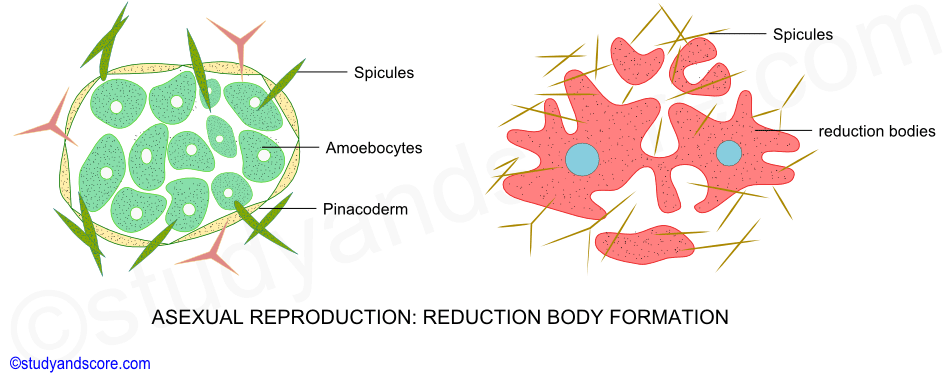
Each reduction body consists of internal mass of amoebocytes covered externally by pinacoderm. When the favourable conditions return, each reduction body develops into a complete new sponge. It gets attached to a suitable substratum and breaks off an osculum at its free distal end.
Gemmules are internals buds formed within the sponge body. It is the characteristic feature of all fresh water and some marine forms like Ficula and Tethya. Gemmules eventually get detached when the parent sponge is decayed. Gemmules help the sponge to tide over unfavourable conditions. Gemmules can withstand freezing and considerably greater degree of desiccation than the adult sponges.
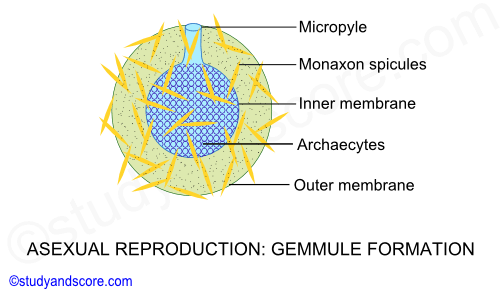
A gemmule is a small, round, hard ball consisting of internal mass of food laden archaeocytes surrounded by chitinous double membrane. The outer protective membrane may be strengthened by siliceous amphidisc spicules (Ephidatia) or by monaxon spicules (Spongilla).
In autumn fresh water sponges suffering from cold and food scarcity get disintegrated leaving behind number of gemmules which remain inert throughout the winter. Gemmules are set free after the decay of the parent sponge. The gemmules thus formed may sink to the bottom or may flow away with the water. In spring, when the conditions become suitable, the gemmules begin to hatch.
The living contents of the gemmules escape out through the micropylar opening and form the new sponge. These new sponge gives rise to summer generation by producing spermatozoa and ova. The summer generation dies off in autumn living behind gemmules which hatch in spring. The life history of such sponges illustrates alternation of generation.
All animals, particularly the less specialized ones, can replace their lost or injured parts. This process is known as regeneration. The power of regeneration is greater in simple animals and simple tissues. Sponges which have low grade of organization exhibit high degree of regeneration power. Thus epithelial tissue regenerates readily whereas highly differentiated tissues such as muscle or nerve tissue have limited power of regeneration.
Sponges are undoubtedly the best at regeneration. As sponges can be cut up tiny pieces or even mashed up into a paste and as long as they have two special cells called collencytes (which produce mesohyl the gelatinous matrix in the sponge that forms a sort of psuedotissue) and archeocytes (which produce all the other cells in the sponges body) the sponge will survive and reform into the spongelet and then into an adult sponge. As long as a fragment of a sponge has these two cells the animal can survive the most brutal of Injuries and in a few weeks be back to its normal form, provided it has favourable environment. This feature makes sponges one of the most awesome animals ever.
The regeneration power of sponges is demonstrated by the experiments carried out by Wilson in 1907.
If a sponge is chopped into small pieces, run through a meat grinder and then squeezed through a fine blotting cloth then all the sponge cells are separated from each other. In a suitable some of these disunited cells unite to form small aggregates or spongelets. In course of several days these spongelets acquire canals, flagellated chambers and skeleton thus growing into new sponge. Cells from different species of sponges may adhere temporarily but later separate without re-forming a sponge.
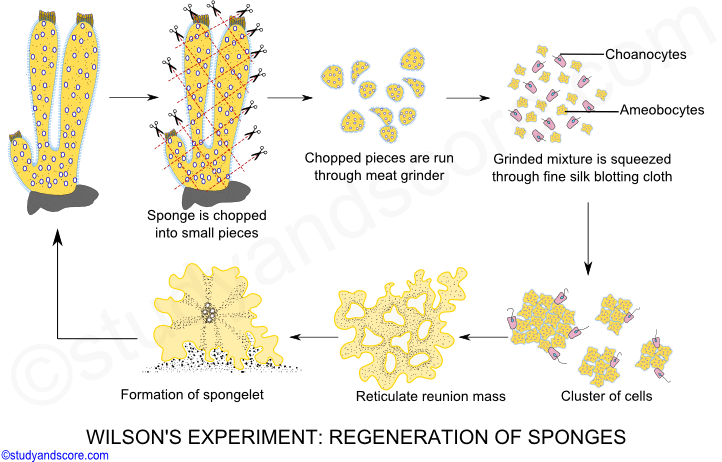
According to the experiments conducted by Bergquist, if a tissue if grafted in a sponge from another sponge of the same species, the host and the graft will grow together. If the graft is from different species, then the host will reject the graft. According to the experiments conducted by Humphrey, calcium and magnesium ions are necessary for regeneration. Some unknown aggregation factors from the cell surface are also supposed to be necessary for the process of regeneration.

- Share with your friends! -
Login to post your comment here...
- or with social Account -